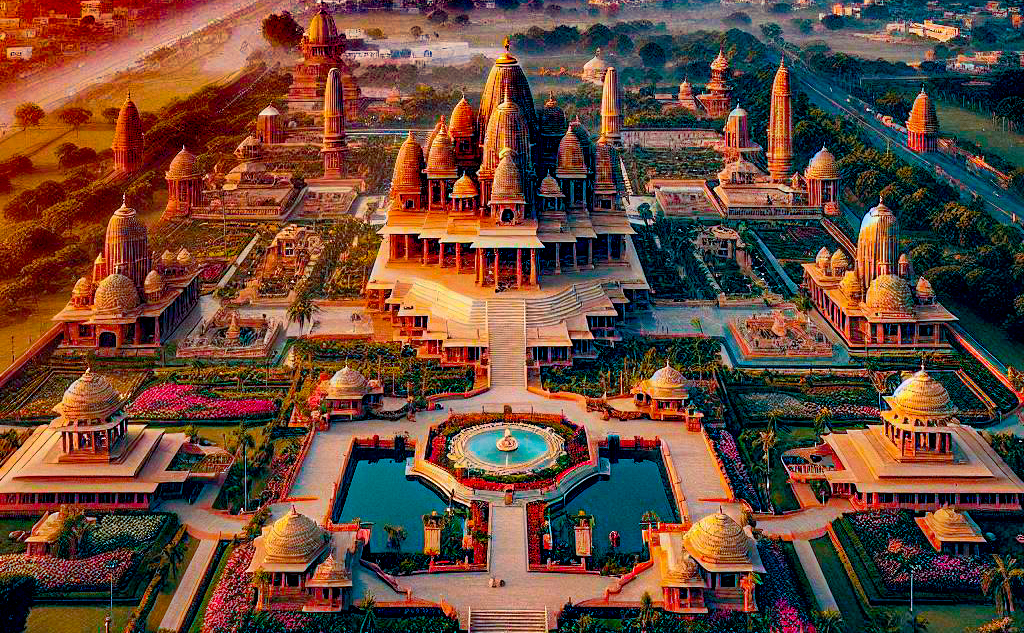In a momentous celebration of faith and architectural splendor, the Ram Janmabhoomi Trust unveiled the awe-inspiring landscape plan for the Ayodhya Ram Janmabhoomi Temple Complex, setting a new benchmark in religious edifices worldwide. The sprawling 110-acre complex, initially planned at 70 acres, stands as an embodiment of reverence and devotion, representing a significant pilgrimage destination for millions of devotees.
Scheduled to commence on January 16 with a seven-day consecration ceremony, the grandeur of this monumental structure resonates with a three-storied temple entrance on the east and an exit on the southern side, mirroring traditional Nagara architectural style. Ascending the 32 steps from the eastern entrance leads pilgrims to the sanctum sanctorum, housing a 51-inch-tall idol of Lord Ram, portraying the divine infant form of Ram Lalla.
Imbued with symbolism and spiritual significance, the temple complex spans 250 feet in width and rises magnificently to 161 feet in height. Comprising a total of 392 pillars and 44 gates across its three floors, the complex showcases meticulous craftsmanship and attention to architectural detail. Uniquely, the Ram Temple features a 14-foot-wide ‘Perkota’ encircling the sanctum sanctorum, paying homage to the Sun God, Maa Bhagwati, Ganesha, and Shiva at its four corners. Additionally, it includes shrines dedicated to revered sages and deities, embodying the rich tapestry of Hindu mythology and culture.
The sanctity of the temple complex extends beyond spiritual realms, manifesting in practical amenities designed for pilgrims’ comfort and convenience. Within its confines lie a pilgrim facility complex, equipped with a health care center and extensive toilet facilities. Notably, a provision has been made for depositing personal belongings like shoes, watches, and mobile phones before seeking darshan, ensuring an uninterrupted spiritual experience.
Acknowledging the significance of environmental consciousness, approximately 70% of the expansive complex is dedicated to lush greenery, featuring centuries-old trees and dense forests. The area boasts a serene ambiance, with ancient trees creating a canopy that shields the earth from direct sunlight, fostering an atmosphere of tranquility and sanctity.
Moreover, the complex of the Temple boasts essential infrastructure, including sewage treatment plants, a water treatment facility, and a dedicated power supply, ensuring self-sufficiency and sustainability. In a nod to thoughtful planning, a fire brigade post is integrated into the complex, sourcing water from an underground reservoir to meet emergencies without compromising on groundwater levels.
Reflecting the ethos of inclusivity, the Ram Janmabhoomi Trust expanded the complex to accommodate 13 additional shrines, catering to diverse sects within the Hindu faith. This expansion, based on religious and Vaastu considerations, epitomizes the harmony between spiritual beliefs and architectural design.
As the consecration ceremony approaches, anticipation swells among devotees and admirers worldwide, heralding the inauguration of a cultural and spiritual landmark that transcends boundaries and resonates with centuries of heritage and devotion.
The Ayodhya Ram Janmabhoomi Temple Complex embodies more than architectural brilliance; it encapsulates the timeless spirit of faith, unity, and profound reverence.

